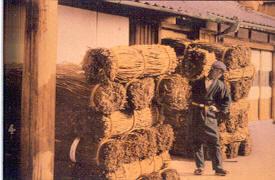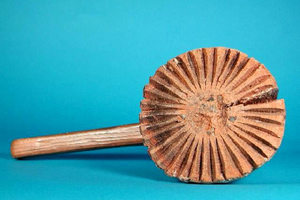
Steaming
Since only the bark of the tree is used for papermaking, the bundles of harvested trees are steamed in a barrel for 2 to 2 ½ hours. The steaming loosens the bark so that it can be easily removed.
Unlike the other fibers, the Gampi plant does not undergo the steaming process. It must be harvested from February to May when the plant is full of water and the bark can be easily removed without steaming.
It takes a village to make a piece of Washi, and the steaming of Kozo and Mitsumata becomes quite a social event.
(text and background only visible when logged in)
Stripping
Once the bark has been loosened by the steaming, it is stripped from the branches. This is done immediately after the steaming process, as this is when the bark is the softest and most flexible.
The long strips of bark are then gathered into bunches and hung out to dry for several days. This bark is called kurokawa or black bark, for its dark color.
Underneath the dark exterior is the shirokawa or "white bark." The white bark is separated from the black bark by a time proven technique of walking upon the bark on flat stones in a running stream.
All of the dark bark as well any scars from insects or other conspicuous impurities must be painstakingly removed in order to produce clean sheet of paper. The remaining wood from the branches can be used as firewood.

(text and background only visible when logged in)

Boiling in Alkali
The white bark is now ready for cooking. First, it is presoaked in cold running water and then boiled in alkali for roughly one hour. It is then allowed to sit in the covered pot for 1-8 hours.
The Boiling process softens the fiber and helps to remove any remaining non-cellulose materials. This process, much like conventional cooking is much about intuition as any given methodology.
(text and background only visible when logged in)
Bleaching
The fibers are then ready for bleaching. The traditional method is to place the fibers in cold running water for up to two days.
Kawa-zarashi or stream bleaching produces a soft white tone and does not weaken the fibers. Today chemical bleaches may aid in this process.
After the bleaching process is completed any scars or residual impurities are picked out by hand in a process called chiri-tori.
Like the steaming of the fibers, the rinsing and cleaning of the pulp is a collective effort that brings the entire community together in making Washi.

(text and background only visible when logged in)

Beating
Following the chiri-tori, the fibers are broken apart into smaller, individual fibers that will allow for the formation of an even sheet of paper.
Fibers are beaten either with wooden mallets or a small mechanical beater. The hand beating technique produces longer fibers with splayed ends which makes a stronger piece of paper.
The fibers are beaten until they resemble wet cotton and do not clump when placed in water. The resulting pulp is almost ready for sheet formation.
(text and background only visible when logged in)
